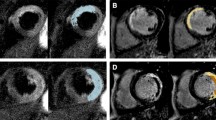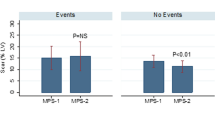Abstract
Background and aims: Patients aged ≥75 years compose a high-risk subgroup for acute myocardial infarction (AMI). It is unknown whether myocardial perfusion in these patients is decreased compared with younger ones after primary percutaneous coronary intervention (PPCI), which may contribute to their worse prognosis. We compared epicardial and myocardial perfusions as well as short-term outcomes between elderly and younger patients undergoing PPCI. Methods: A total of 547 consecutive PPCI patients were prospectively enrolled; of these, 106 were elderly (≥75 yrs). Epicardial perfusion was evaluated by the Thrombolysis in Myocardial Infarction (TIMI) flow grade and corrected TIMI frame count (CTFC), and myocardial perfusion was evaluated by the TIMI myocardial perfusion grade (TMPG) and ST-segment resolution (STR). Results: Despite comparable epicardial perfusion pre- and post-PPCI, elderly patients had impaired myocardial perfusion after PPCI, as measured by reduced TMPG (35.9% vs 14.5%, p=0.001) and absent STR (18.9% vs 9.8%, p=0.009). After adjusting for clinical and angiographic risk profiles, multivariate analysis showed that age ≥75 years remained independently associated with reduced TMPG or absent STR. In the whole population, multivariate analysis revealed that both age ≥75 years and absent STR were independently associated with 3-month major adverse cardiac events (MACE). In the elderly subgroup, multivariate analysis identified absent STR as the strongest determinant of 3-month MACE. Conclusions: Age is associated with impaired myocardial perfusion, but not epicardial perfusion, after PPCI for AMI. To further improve the outcome of elderly AMI patients, efforts should be aimed at improving myocardial perfusion beyond epicardial recanalization.
Similar content being viewed by others
References
Klein LW. Optimal revascularization strategies for ST-segment elevation myocardial infarction in the elderly patient. Am J Geriatr Cardiol 2007; 16: 295–303.
Gurwitz JH, Col WF, Avorn J. The exclusion of the elderly and women from clinical trials in acute myocardial infarction. JAMA 1992; 268: 1617–22.
Alexander KP, Newby LK, Armstrong PW et al. Acute coronary care in the elderly, Part II: ST-segment-elevation myocardial infarction: a scientific statement for healthcare professionals from the American Heart Association Council on Clinical Cardiology: in collaboration with the Society of Geriatric Cardiology. Circulation 2007; 115: 2570–89.
Mehta RH, Sadiq I, Goldberg RJ et al. Effectiveness of primary percutaneous coronary intervention compared with that of thrombolytic therapy in elderly patients with acute myocardial infarction. Am Heart J 2004; 147: 253–9.
Prasad A, Stone GW, Aymong E et al. Impact of ST-segment resolution after primary angioplasty on outcomes after myocardial infarction in elderly patients: an analysis from the CADILLAC trial. Am Heart J 2004; 147: 669–75.
Ding S, Pu J, Qiao ZQ et al. TIMI myocardial perfusion frame count: a new method to assess myocardial perfusion and its predictive value for short-term prognosis. Catheter Cardiovasc Interv 2010; 75: 722–32.
Ramaraj R, Movahed MR. Microvascular dysfunction following primary percutaneous coronary intervention in the setting of ST-elevation myocardial infarction. J Invasive Cardiol 2008; 20: 603–14.
Brener SJ, Moliterno DJ, Aylward PE et al. Reperfusion after primary angioplasty for ST-elevation myocardial infarction: predictors of success and relationship to clinical outcomes in the APEX-AMI angiographic study. Eur Heart J 2008; 29: 1127–35.
The Joint European Society of Cardiology/American College of Cardiology Committee. Myocardial infarction redefined — a consensus document of the Joint European Society of Cardiology/American College of Cardiology Committee for the redefinition of myocardial infarction. J Am Coll Cardiol 2003; 36: 959–69.
TIMI Study Group. The Thrombolysis in Myocardial Infarction (TIMI) Trial: phase I findings. N Engl J Med 1985; 312: 932–6.
Gibson CM, Cannon CP, Daley WL et al. TIMI frame count: a quantitative method of assessing coronary artery flow. Circulation 1996; 93: 879–88.
Gibson CM, Cannon CP, Murphy SA et al. Relationship of TIMI myocardial perfusion grade to mortality after administration of thrombolytic drugs. Circulation 2000; 101: 125–30.
Rentrop KP, Cohen M, Blanke H, Phillips RA. Changes in collateral channel filling immediately after controlled coronary artery occlusion by an angioplasty balloon in human subjects. J Am Coll Cardiol 1985; 5: 587–92.
Schröder R, Dissmann R, Brüggemann T et al. Extent of early ST segment elevation resolution: a simple but strong predictor of outcome in patients with acute myocardial infarction. J Am Coll Cardiol 1994; 24: 384–91.
Sabatine MS, McCabe CH, Gibson CM, Cannon CP. Design and rationale of clopidogrel as adjunctive reperfusion therapy — Thrombolysis in Myocardial Infarction (CLARITY-TIMI) 28 trial. Am Heart J 2005; 149: 227–33.
Di Mario C, Bolognese L, Maillard L et al. Combined Abciximab REteplase Stent Study in acute myocardial infarction (CARESS in AMI). Am Heart J 2004; 148: 378–85.
Zeymer U, Suryapranata H, Monassier JP et al. The Na+/H+ exchange inhibitor eniporide as an adjunct to early reperfusion therapy for acute myocardial infarction. Results of the evaluation of the safety and cardioprotective effects of eniporide in acute myocardial infarction (ESCAMI) trial. J Am Coll Cardiol 2001; 38: 1644–50.
Mamoun NF, Xu M, Sessler DI, Sabik JF, Bashour CA. Propensity matched comparison of outcomes in older and younger patients after coronary artery bypass graft surgery. Ann Thorac Surg 2008; 85: 1974–9.
D’Agostino RB Jr. Propensity scores in cardiovascular research. Circulation 2007; 115: 2340–3.
Assali AR, Moustapha A, Sdringola S et al. The dilemma of success: percutaneous coronary interventions in patients ≥75 years of age — successful but associated with higher vascular complications and cardiac mortality. Catheter Cardiovasc Interv 2003; 59: 195–9.
Wenaweser P, Ramser M, Windecker S et al. Outcome of elderly patients undergoing primary percutaneous coronary intervention for acute ST-elevation myocardial infarction. Catheter Cardiovasc Interv 2007; 70: 485–90.
Barron HV, Bowlby LJ, Breen T et al. Use of the reperfusion therapy for acute myocardial infarction in the United States: data from the National Registry of Myocardial Infarction 2. Circulation 1998; 97: 1150–6.
Rich MW. Treatment of acute myocardial infarction. Am J Geriatr Cardiol 2001; 10: 328–36.
Ciszewski A, Karcz M, Kepka C et al. Primary angioplasty in patients ≥75 years old with ST-elevation myocardial infarction — one-year follow-up results. Kardiol Pol 2008; 66: 828–33.
Wilkerson WR, Sane DC. Aging and thrombosis. Semin Thromb Hemost 2002; 28: 555–68.
Cosentino F, Osto E. Aging and endothelial dysfunction. Clin Hemorheol Microcirc 2007; 37: 143–7.
Author information
Authors and Affiliations
Corresponding author
Additional information
This work was in part presented at the 2008 European Society Cardiology Congress (Munich, Germany, August 30, 2008).
Rights and permissions
About this article
Cite this article
Pu, J., Ding, S., Shan, P. et al. Comparison of epicardial and myocardial perfusions after primary coronary angioplasty for ST-elevation myocardial infarction in patients under and over 75 years of age. Aging Clin Exp Res 22, 295–302 (2010). https://doi.org/10.1007/BF03337726
Received:
Accepted:
Published:
Issue Date:
DOI: https://doi.org/10.1007/BF03337726




